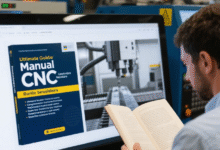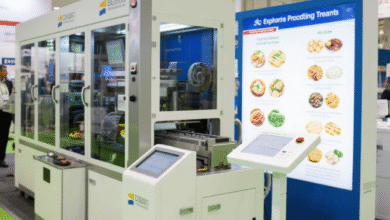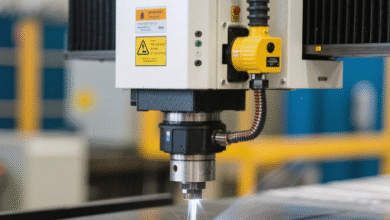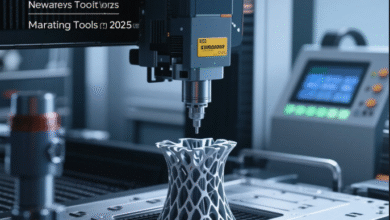Industrial Cutting: Safety Guidelines to Follow
Advertisement
Introduction
In any industrial setting, safety should always be the number one priority. Industrial cutting is a common task in many manufacturing and construction environments, but it comes with inherent risks. It is essential for workers to be aware of safety guidelines to prevent accidents and injuries.
Industrial cutting involves the use of various tools and machinery to cut different materials such as metal, wood, plastic, and more. While it is an essential part of many processes, it can also be dangerous if proper precautions are not taken. Workers must be equipped with the knowledge and skills to perform cutting tasks safely.
These safety guidelines are designed to protect workers from hazards associated with industrial cutting. By following these guidelines, employers can create a safe work environment and reduce the risk of accidents and injuries. Let’s explore some key safety measures that should be followed when performing industrial cutting tasks.
Strengths of Safety Guidelines
One of the main strengths of safety guidelines for industrial cutting is that they provide clear and actionable instructions for workers to follow. These guidelines outline specific safety measures that must be taken to prevent accidents and injuries. By following these guidelines, workers can reduce the risk of harm and create a safer work environment.
Another strength of safety guidelines is that they are based on industry best practices and regulatory standards. These guidelines are developed by experts who understand the risks associated with industrial cutting and how to mitigate them effectively. By following these standards, employers can ensure that their workers are working in a safe and compliant manner.
Safety guidelines also help to raise awareness about the importance of safety in the workplace. By emphasizing the need to follow these guidelines, employers can instill a safety culture within their organization. This culture shift can lead to increased vigilance and adherence to safety protocols, ultimately reducing the number of accidents and injuries.
Furthermore, safety guidelines help to improve productivity and efficiency in the workplace. When workers are confident in their safety, they can focus on their tasks without distraction or fear. This leads to better job performance and a more positive work environment. By following safety guidelines, employers can create a conducive work environment that promotes employee well-being and productivity.
Additionally, safety guidelines contribute to cost-savings for employers. By preventing accidents and injuries, companies can avoid costly medical bills, insurance claims, and potential legal fees. Ensuring a safe work environment through compliance with safety guidelines can ultimately save companies money in the long run.
It is clear that safety guidelines play a vital role in protecting workers and promoting a safe work environment. By following these guidelines, employers and employees alike can benefit from increased safety, productivity, and cost-savings.
Weaknesses of Safety Guidelines
While safety guidelines are essential for protecting workers, there are also some weaknesses that should be considered. One weakness is that not all workers may fully understand or comply with safety guidelines. This can lead to lapses in safety protocols and increase the risk of accidents and injuries.
Another weakness is that safety guidelines are not always updated to reflect changes in technology or best practices. As new cutting tools and techniques are developed, safety guidelines may need to be revised to address emerging risks. Failure to update guidelines regularly can leave workers exposed to new dangers and vulnerabilities.
Sometimes, safety guidelines may be seen as a hindrance to productivity. Workers may perceive safety measures as time-consuming or restrictive, leading them to take shortcuts or ignore safety protocols. This can compromise the effectiveness of safety guidelines and increase the likelihood of accidents and injuries.
Furthermore, safety guidelines may not always account for unique or unforeseen situations in the workplace. While they provide a general framework for safety, guidelines may not address every possible scenario or hazard that workers may encounter. This can leave workers unsure of how to respond in unfamiliar or emergency situations.
There can also be inconsistencies in enforcing safety guidelines across different work environments. Some employers may prioritize safety more than others, leading to varying levels of compliance among workers. Inconsistent enforcement of safety guidelines can create confusion and reduce the overall effectiveness of safety measures.
In some cases, safety guidelines may be perceived as overly prescriptive or burdensome. Workers may feel overwhelmed by the sheer number of guidelines they are expected to follow, leading to compliance fatigue and a lack of engagement with safety protocols. This can undermine the purpose of safety guidelines and leave workers vulnerable to accidents and injuries.
Despite these weaknesses, safety guidelines remain a critical component of workplace safety. By addressing these weaknesses and implementing strategies to overcome them, employers can strengthen the effectiveness of safety guidelines and create a safer work environment for their workers.
Industrial Cutting: Safety Guidelines Table
| Guidelines | Description | Importance |
|---|---|---|
| Personal Protective Equipment | Wear appropriate PPE such as gloves, goggles, and ear protection. | Protects from injuries and exposure to hazardous materials |
| Training and Certification | Ensure workers are trained and certified to operate cutting equipment | Prevents accidents and ensures proficiency |
| Machine Maintenance | Regularly maintain and inspect cutting machinery for safety | Reduces the risk of equipment failure and accidents |
| Safe Work Practices | Follow proper procedures for cutting, handling materials, and waste disposal | Prevents accidents and promotes efficiency |
| Emergency Response Plan | Have a plan in place for emergencies and evacuate workers safely | Ensures quick and effective response in case of accidents |
Frequently Asked Questions (FAQs)
1. What are the common hazards associated with industrial cutting?
Industrial cutting poses risks such as lacerations, amputations, eye injuries, and exposure to hazardous materials. Workers must be aware of these dangers and how to prevent them.
2. How often should cutting equipment be inspected for safety?
Cutting equipment should be inspected regularly, preferably before each use, to ensure it is in proper working condition and free of defects.
3. What should workers do in case of a cutting-related injury?
Workers should seek immediate medical attention for any injuries and report the incident to their supervisor. Proper documentation of injuries is essential for workplace safety.
4. Can cutting equipment be used without proper training?
No, workers should not operate cutting equipment without proper training and certification. Lack of training can lead to accidents and injuries.
5. How can employers promote a safety culture in the workplace?
Employers can promote safety by providing regular training, enforcing safety guidelines, and rewarding safe behaviors. Creating a culture of safety is essential for preventing accidents.
6. What are the consequences of not following safety guidelines?
Failure to follow safety guidelines can result in injuries, costly medical bills, legal repercussions, and damage to equipment. It is crucial to prioritize safety in the workplace.
7. How can workers stay vigilant and proactive about safety?
Workers can stay vigilant by attending safety training sessions, following safety protocols, reporting hazards, and actively participating in safety programs. Safety is everyone’s responsibility.
Conclusion
In conclusion, safety guidelines are essential for protecting workers in industrial cutting environments. By following these guidelines, employers can create a safe work environment, reduce the risk of accidents and injuries, and promote a culture of safety. It is crucial for both employers and employees to prioritize safety and adhere to established guidelines to ensure a safe and productive workplace.
Remember, safety is everyone’s responsibility. By taking proactive measures and following safety guidelines, we can create a safer work environment for all. Let’s work together to make industrial cutting tasks safer and more efficient for everyone involved.
Stay safe, stay informed, and always prioritize safety in your workplace. Together, we can prevent accidents and create a culture of safety that benefits everyone. Take action today to ensure a safer tomorrow for all.
Disclaimer
The information provided in this article is for educational purposes only and should not be considered as professional advice. It is essential to consult with safety experts and regulatory authorities to ensure compliance with safety standards in your specific work environment. Always prioritize safety and follow established guidelines to prevent accidents and injuries in industrial cutting tasks.









